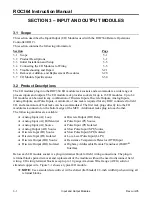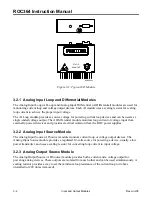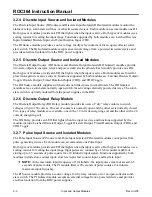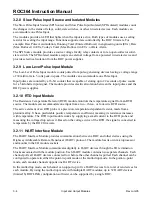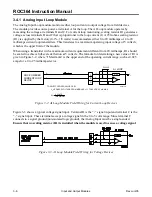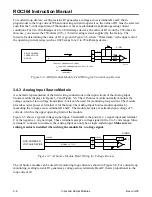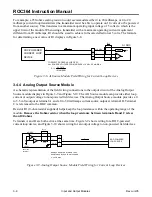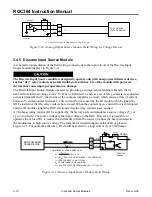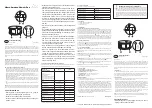
ROC364 Instruction Manual
3-15
Input and Output Modules
Rev Jun/05
+
–
SELF-POWERED
PULSE DEVICE
R
W
= RESISTANCE OF FIELD WIRING
V
O
= VOLTAGE FROM PULSE DEVICE = 11 TO 30 VDC
R1 + R
W
+ 2.2K = LOOP RESISTANCE = 3.4K OHMS
– R
W
– 2.2K
TO OPTIMIZE SCALING RESISTOR R1:
I = LOOP CURRENT = 5 mA TYPICAL
R1 =
V
O
V
O
– 1
I
R
W
C
B
+
–
A
N/C
DOC0149A
R1=10
2.2K
PI ISO
Figure 3-17. Pulse Input Isolated Module Field Wiring
3.4.12 Slow Pulse Input Source Module
A schematic representation of the field wiring connections to the input circuit of the Slow Pulse Input
Source (SPI) module is shown in Figure 3-18.
The Slow Pulse Input source module is designed to operate only with non-powered devices, such
as “dry” relay contacts or isolated solid-state switches. Use of the module with powered devices
may cause improper operation or damage to occur.
The Slow Pulse Input Source module operates by providing a voltage across terminals B and C
that is derived from internal voltage source V
s
. When a field device, such as a set of relay contacts,
is connected across terminals B and C, the closing of the contacts completes a circuit, which causes a
flow of current between V
s
and ground at terminal C.
This current flow is sensed by the SPI module, which signals the ROC electronics that the relay contacts
have closed. When the contacts open, current flow is interrupted and the SPI module signals the ROC
electronics that the relay contacts have opened. The ROC counts the number of times the contacts switch
from open to closed, and stores the count. The ROC checks for the input transition every 50
milliseconds.
A 10-ohms scaling resistor (R1) is supplied and accommodates a source voltage (V
s
) of 11 to 30 volts
dc. The source voltage is either the input voltage to the ROC. However, it is desirable to optimize the
value of R1 to reduce the current drain from the source or reduce the heat generated in the module due to
high source voltage. The formula for determining the value of R1 is given in Figure 3-18. For optimum
efficiency, R1 should be scaled for a loop current (I) of 3 milliamps.

